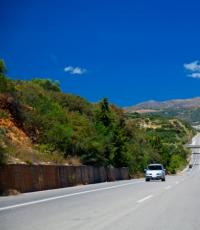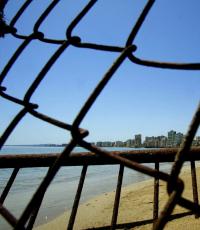Noah's ark is a novelty in Chechnya. An amateur Chechen historian claims to have unearthed Noah's Ark. Professionals don't believe. Mufti of the Chechen Republic Salakh Mezhiev on the discovery of Noah's Ark
In Chechnya, enthusiasts and scientists continue to explore the Noah's Ark on Sadoi-Lam mountain in the Cheberloevsky region of the republic. Three years ago, a lonely local resident, Marat Makazho, found here an amazing formation of layered limestones, surprisingly similar to wooden beams.
I just walked through the alpine meadows in the mountains, a little higher than Lake Kezenoyam. I admired the beauty of nature, explored the area. The strange rise above the plateau aroused my interest. From there it was very pleasant to admire the surroundings, I often came to it just to sit. Then he began to examine the stones and noticed that they were already very even, smooth and beautiful in this place. As if specially adjusted to each other. I became interested in their origin, completely not understanding what I was dealing with, just out of curiosity. This is how this story began, - said “ Komsomolskaya Pravda»Marat.
"Gate of the Ark" Photo:
The man spent the next year in libraries, researching historical sources and geological manuals. Who could grind limestone so delicately? What for? And what kind of man-made structure can be located on a plateau high in the mountains?
The insight came with the thought that it might not be a stone at all, but a petrified tree. That was when I first thought about the Ark. At first I was skeptical about this, - says Marat. - I often went to the mountains, researched. But the deeper I studied the topic, the less doubts remained. The final conviction came when I saw something that I cannot call other than a sign. It was like a "phenomenon" from canon legends: slightly gloomy weather, a sky covered with clouds. I am going to the plateau in thought. And then a ray of bright light escaping from behind the clouds falls on the place that we now call the “gates of the Ark”!
Marat Makazho talks about Noah's Ark in Chechnya.
Mufti of the Chechen Republic Salakh Mezhiev on the discovery of Noah's Ark
Marat spent another year studying theological literature and the history of the search for the Ark. Of course, most of the clergy claimed that the ancient ship of the prophet stopped at Mount Ararat. But a long search and scientific research yielded nothing. Formations that truly resemble the ship were never found, and archaeologists and geologists, not finding a skeleton on the mountain, moved to other regions of Turkey. Another part of Islamic scholars indicates that the Ark could have stopped in another place.
According to one of the widespread theories put forward by Islamic scholars, the ship could sail further north and run aground in the Caucasus mountains, - explained the mufti of the Chechen Republic Salakh Mezhiev to Komsomolskaya Pravda. - Moreover, here, in the North Caucasus, there is a people who bears the name of the prophet. In Arabic, Noah is called Nuh, or Noh. And true Vainakhs know that the real name of the Chechen people is Nokhchi. That is, in other words, the sons of Noh.

On this map, everyone can find a unique phenomenon discovered by Marat Makajo Photo: Personal archive of the hero of the publication
The coincidences amazed Marat. And two years later, he began to speak publicly that he had found Noah's Ark. An initiative group immediately gathered around it, enthusiasts, having personally looked at the phenomenon, without regret invested their own funds in its study, and excavations soon began.
The unique natural site amazed even scientists. They hypothesized that multi-layered limestones were formed under colossal water pressure. Most likely - at the bottom of the Tethys Ocean, which existed in the North Caucasus millions of years ago. But the origin of the "nails" that dot the limestone layers is more difficult to explain.

Photo: Personal archive of the hero of the publication
We were visited by an expedition of the Crimean branch of the "Russian Geographical Society", specialists from the Central Research Institute of Geology of Nonmetallic Mineral Resources. Scientists, over a glass of beer, honestly told that they were amazed at some of the details, and education in the mountains of Chechnya is really worth studying, ”says Marat Makazho. - But the analysis of limestone samples did not give positive results for us. Therefore, we cannot yet announce the find to the whole world. We continue excavations.
At the same time, the scientists themselves speak of the Chechen enthusiast with great warmth and respect his convictions.

Even scientists find it difficult to answer the question of the origin of the nails with which limestone is stuck. Photo: Personal archive of the hero of the publication
Marat is a very interesting, intelligent person. It does not in any way resemble a local madman who composed a beautiful legend and believed in it, - said geologist and speleologist Gennady Samokhin, who heads the expedition of the Crimean branch of the Russian Geographical Society. - As a scientist, I, of course, cannot seriously assume that this is the mythical Noah's Ark. But the object he discovered is really extremely interesting and deserves a detailed study. I sincerely wish you the best of luck with his research.
Enthusiasts have to work very carefully - they are afraid to damage the shrine. Now they have managed to penetrate 25 meters into the limestone. The members of the initiative group are confident that they will find voids inside - internal premises legendary ship... And they hope that this find will prove to all skeptics that Noah's Ark is really in Chechnya.

The most important test for the initiative group was the visit of representatives of the Spiritual Directorate of Muslims of Chechnya. After him, the muftiate of the republic did not doubt the authenticity of the Ark.
After investigating the object by our representatives, I can confidently say that Noah's Ark is in Chechnya, - said the Mufti of the Chechen Republic Salakh Mezhiev. - This is our position. May Allah grant that the studies of the skeleton found in the mountains finally confirm this! We believe and hope that this will happen soon.
REFERENCE "KP"
How many times has the Ark been found?
Attempts to find the Ark have been made since about the 4th century AD. According to the biblical legend, he had to stop on the slope of Mount Ararat. There are several other areas that are considered its potential location. One of the main places, in the opinion of the seekers, is the so-called Ararat anomaly - the "outlines of a ship" protruding from the snow on the northwestern slope of Ararat. Scientists explain its formation by natural causes, however, on-site research is difficult, since the area is a military closed zone in the area of the Armenian-Turkish border.

1. One of those who "found" the Ark was the Russian military pilot Vladimir Roskovitsky, who during the First World War, flying over Mount Ararat, saw what he called "a large ship lying down." The pilot wrote a report about what he saw, and in 1917 Russia allegedly even sent an expedition there, which took several photographs of the Ark, but during the revolution the report on the expedition disappeared. Later, other pilots, in particular the Turk Durupinar in 1957, took photographs of a strange contour, similar to a ship, near Mount Ararat. The photograph of Durupinar even got into the Life magazine and became the reason for the next expeditions, each of which announced the discovery of the Ark.

2. In 1955, the French explorer Fernand Navarra brought from Ararat the remains of a board that, according to him, was broken off from the wooden skeleton of the Ark. Some of the studies have partially confirmed the tree is 5,000 years old, but these findings have been highly subjective.
3. A joint Turkish-Hong Kong expedition to Mount Ararat in 2010 made a statement that they found Noah's Ark at an altitude of 4000 meters frozen into a glacier and even penetrated some rooms inside the Ark, taking video and photographs. However, there is a version that all these footage were edited to create a worldwide sensation. Professional archaeologists do not take the claims of the Ark seekers seriously, considering all their discoveries to be a figment of the imagination.
The riddle of Noah's Ark has attracted not only theologians, but also scientists for many years. And among those, and among others, there are enough people who dream of proving that the Ship, thanks to which mankind was saved from the Great Flood, is not a myth. Until now, researchers of the topic assumed that the Ark should be sought on Mount Ararat, to which, according to the Bible, he stuck. However, none of the expeditions even 50 percent confirmed the existence of the Ark, despite the fact that many of its alleged fragments were found, as well as the outline of the ship itself on Mount Ararat. Therefore, hypotheses about its location continue to appear.
In the Chechen Republic, the local explorer Marat Makazho took up the subject of the Ark after he found strange fossils on the mountain Sadoi-Lam of the republic.
While walking, I noticed layers of rock protruding from the mountain, similar in texture to logs, - he recalls. - The stones adhered to each other evenly and tightly, like beams in a ship. In the stones themselves, I did not find any admixtures of local clay, they looked like man-made ones.
Photo: Marat Makajo claims that these fossils were once the logs of the Ark. / @ kp.ru
The size of the fossils, as well as a quadcopter survey, which made it possible to see that the mountain has the outline of a large ship, prompted Marat to think that it might not be just a ship.
The dimensions of the hill are quite suitable for the dimensions of the Ark described in the Scriptures, - says Marat. - I began to question the elders who live near Mount Sadoi-Lam. And they said that during the construction of the mosque almost 100 years ago, two giant wooden beams were found on a high plateau. According to them, the tree came from nowhere. The beams were so large that no one could lift them - they dragged them with difficulty, and now our mosque stands on them. Other residents with whom I spoke, recall many strange and even mystical stories associated with the mountain.
However, Marat has not yet been able to convince archaeologists to start excavations:
They shrug their shoulders and do not believe in the very possibility of finding the mythical, according to them, Ark.
Hope was given to Marat by the expedition of the Russian Geographical Society, which plans to go to Chechnya and study the fossils in more detail. In the meantime, the "discoverer" of the Ark is excavating himself with the help of his associates and is trying to attract experts to the topic by publishing videos of his observations on the Internet. We asked Professor, Doctor of Geological and Mineralogical Sciences and Chief Researcher of the Geological Institute of the Russian Academy of Sciences Vladimir Trifonov to look at one of these records.
It looks more like limestone deposits, which in the Caucasus have their own special origin, - he commented. - These structures were formed on the bottom of the Tethys Ocean, which existed on the site of the North Caucasus millions of years ago. Such artifacts are rarely so high, but due to the movement of tectonic plates, this is quite possible and most likely. Visually, it may resemble a tree, but due to the influence of the environment, it can weathered and take on an amazing shape.
As far as I know, there have been several such cases. They all have a distinctive feature: people see something visually similar to the remains of an ancient ship. Two of the most striking cases were recorded in Turkey, directly at the foothills and not far from Mount Ararat. In one case, these were sediments that formed relatively recently. They acquired their shape due to external influences, that is, washing out and weathering. However, their structure was too strikingly different from petrified wood, which most often quartz (partially converted into quartz - Ed.), And almost never remains soft, like the same limestone. In the second case, the structure was solid, these were quite old rocks, which even aroused the interest of scientists. A group of geophysicists from Japan studied this formation and set up experiments, but they could not provide strong evidence.
How many times has the Ark been found?
Attempts to find the Ark have been made since about the 4th century AD. According to the biblical legend, he had to stop on the slope of Mount Ararat. There are several other areas that are considered its potential location. One of the main places, in the opinion of the seekers, is the so-called Ararat anomaly - the "outlines of a ship" protruding from the snow on the northwestern slope of Ararat. Scientists explain its formation by natural causes, however, on-site research is difficult, since the area is a military closed zone in the area of the Armenian-Turkish border.

Photo: Alleged remains of Noah's Ark near Mount Ararat in Turkey / Mfikretyilmaz - Own work, CC BY 3.0, https://commons.wikimedia.org
1. One of those who The Ark was "found" by the Russian military pilot Vladimir Roskovitsky, who during the First World War, flying over Mount Ararat, saw what he called "a lying large ship." The pilot wrote a report about what he saw, and in 1917 Russia allegedly even sent an expedition there, which took several photographs of the Ark, but during the revolution the report on the expedition disappeared. Later, other pilots, in particular the Turk Durupinar in 1957, took photographs of a strange contour, similar to a ship, near Mount Ararat. The photograph of Durupinar even got into the Life magazine and became the reason for the next expeditions, each of which announced the discovery of the Ark.

Photo: Turok Durupinar in 1957 took a photograph from an airplane of a strange outline, similar to a ship, near Mount Ararat
2. In 1955, the French explorer Fernand Navarra brought from Ararat the remains of a board that, according to him, was broken off from the wooden skeleton of the Ark. Some of the studies have partially confirmed the tree is 5,000 years old, but these findings have been highly subjective.
3. A joint Turkish-Hong Kong expedition to Mount Ararat in 2010 made a statement that they found Noah's Ark at an altitude of 4000 meters frozen into a glacier and even penetrated some rooms inside the Ark, taking video and photographs. However, there is a version that all these footage were edited to create a worldwide sensation. Professional archaeologists do not take the claims of the Ark seekers seriously, considering all their discoveries to be a figment of the imagination.
In 2003, the expedition under my leadership went to the legendary Mount Ararat, where, as mentioned in the Old Testament, the ark of the forefather Noah moored. At that time, my comrades and I wanted to check three points on the mountain, where Noah's ark was supposedly seen in different years and centuries. Due to unforeseen circumstances, the expedition then had to be curtailed.
In 2004, we moved to Nakhichevan, which some researchers also associate with post-Flood times, moreover, it was there, according to one of the versions, that Noah's burial was located. All this has already been described and told many times in various Russian and world media outlets. After our expeditions to the Ararat region, several others followed. But the ancient ship was never discovered by anyone.
Unexpectedly, quite recently, I received a message from Chechnya, stating that Noah's Ark was found there. In confirmation, a link was given to the channel of the author of the sensation Marat Makajo on YouTube.
I managed to ask a few questions to Marat:
- Marat, how did you discover the formation that you call Noah's ark?
I was sure that the ark was in Chechnya. When I took a photograph to find out what it looked like, a ray of light pointed it at me. After a year of studying the object, there was no doubt that the education was not of local origin and could not be anything other than an ark.
- Why are you sure that this is the ark of Noah?
I am sure, because at the moment I have been studying it for 2 years and more and more I find secondary signs.
- Have there been any scientific studies?
Unknown, but I managed to find the excavation site. If someone was digging there now, we would know about it. Consequently, the excavation was made during our eviction, since we were not evicted in order to return back, no one expected this from Khrushchev. Soon after our return, a fairy tale about the ark on Ararat was invented, a picture was shown with the involvement of Chinese specialists, most likely just guest workers, and this bluff was presented to the world.
- Is it possible to organize a full-fledged, comprehensive expedition to the area where the supposed Noah's ark is located?
The question of the expedition must be coordinated with the authorities, and, most likely, with the federal ones. I can only give an excursion, and even then, only in private.
- In a video clip on your Youtube channel, you said that you are ready to swear on the Koran that you discovered Noah's ark. What is your confidence based on?
I am ready to swear and give my head to be cut off, because after studying it for 2 years now, I find more and more signs that this object was made of wood.
- There is a legend, and you also mention about it, that when Noah's ark is opened to mankind, the so-called end of the world or the Apocalypse will come. Do you think that the End Times has already arrived?
I heard the legend, I'm sure that the Last Times have come, but we are unlikely to find the Apocalypse, but rather our children or grandchildren.
- There is a version that the self-name of the Chechens - Nokhchi - is translated as “the people of Noah”. Does your find confirm this?
The self-name Nokhchi really comes from the prophet Noh (Noah), I'm sure of that.
Earlier, I have repeatedly said that in the antediluvian times, shipping was highly developed. The Sumerians had a very impressive fleet, which included ships of different displacement and could move both close and long distances. If we assume that the water simultaneously began to rise over the entire land or in some of its parts with a change in the geological appearance, then some of the ships could go to drainage voyages. An indirect confirmation of this was found in one of the European libraries by the late polyglot, a member of our expedition to Nakhichevan, Willi Melnikov. An ancient manuscript, which he called "The Second Ark", told that the people who sailed with Noah on the ark saw a similar huge ship, but when they managed to get close to it, it turned out to be completely deserted.
In general, legends about the Flood are found among many peoples of the Earth in different interpretations, people, according to ancient authors, escaped by boats, trees, and in other ways. Therefore, both Noah's Ark itself and any other ship of that era can rest in the mountains of Chechnya. A full-fledged scientific expedition could help solve the new riddle. This is exactly what Marat Makazho is counting on, although he himself is sure of the authenticity of his find and he does not need to personally prove anything.
Andrey Polyakov (photo by Marat Makazho)
YET
The mystery of this artifact has been attracting researchers for many years. There are many theologians and real scientists who are trying to prove that this ship, thanks to which it was possible to escape from the Great Flood, really existed. Numerous expeditions and searches around the world regularly provide "evidence" - and now the Chechen seeker Marat Makazho claims to have found the notorious Ark.
Until recently, numerous researchers argued that the mysterious Ark should be sought on Mount Ararat. However, none of the expeditions undertaken there, despite the allegedly found fragments of the ship, even 50% did not confirm its existence. Therefore, hypotheses about its location appear every year and seekers are sent on new expeditions.

Chechen researcher Marat Makazho became interested in the topic of the Ark after strange fossils found on the Sadoi-Lam mountain in the Republic of Chechnya.

Their size, as well as filming from a quadcopter, made it possible to see that what was previously mistaken for a mountain could be a huge ship.

Marat says:“The dimensions of the hill are quite suitable for the dimensions of the Ark described in the Scriptures. I began to question the elders who live near Mount Sadoi Lam. And they said that during the construction of the mosque almost 100 years ago, two giant wooden beams were found on a high plateau. According to them, the tree came from nowhere. The beams were so large that no one could lift them - they dragged them with difficulty, and now our mosque stands on them. Other residents with whom I spoke, recall many strange and even mystical stories associated with the mountain. "
In the future, a more detailed study of this mountain is planned - an expedition of the Russian Geographical Society will go to Chechnya. In the meantime, the correspondents of the Komssomolskaya Pravda newspaper asked to comment on the video of Vladimir Trifonov, Professor, Doctor of Geological and Mineralogical Sciences and Chief Researcher of the Geological Institute of the Russian Academy of Sciences:
- It looks more like limestone deposits, which have their own special origin in the Caucasus. These structures formed at the bottom of the Tethys Ocean, which existed in the North Caucasus millions of years ago. Such artifacts are rarely so high, but due to the movement of tectonic plates, this is quite possible and most likely. Visually, it may resemble a tree, but due to the influence of the environment, it can weathered and take on an amazing shape.
Whether this is really so is to be determined by specialists.




